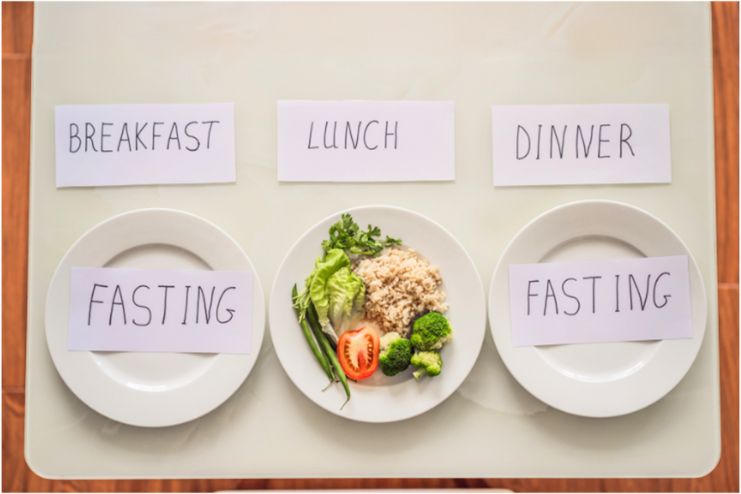Affiliate Disclaimer
Some links in this article are affiliate links. We may earn a small commission if you make a purchase through these links, at no extra cost to you. We only recommend products we find useful to our readersIntroduction: What Is Intermittent Fasting?
Intermittent fasting, or IF, has become extremely popular in the health and wellness community as a revolutionary method to boost metabolism, help control weight, and improve general health. This eating pattern offers flexibility and several health advantages by alternating between eating and fasting.
OMAD (One Meal a Day) and the 16:8 method are two of the most notable intermittent fasting techniques. While the 16:8 technique organizes eating inside an 8-hour window and fasting for 16 hours, OMAD emphasizes eating one large meal within one hour each day. Both strategies address distinct lifestyles and health goals.
Which of these intermittent fasting methods is best for your goals? Read on as we delve into the pros, cons, and unique aspects of OMAD and 16:8 to help you decide the right path for your wellness journey.
READ MORE: Common Myths About Fasting
What Is OMAD?

OMAD, or One Meal a Day, is a unique approach to intermittent fasting that involves eating all your daily calories in one meal during a one-hour window, followed by fasting for the remaining 23 hours. This method emphasizes simplicity and encourages a calorie deficit, making it appealing for those seeking weight loss or minimal meal planning.
How Does it Work?
Essentially, OMAD fasting involves extending the time the body goes without eating. This pushes it towards burning stored fat for energy.
This means only water or other zero-calorie diets like black coffee or tea are allowed during fasting. One meal must also be nutrient-rich to meet daily dietary requirements.
Benefits and Challenges
Benefits of OMAD include its straight form, reduced meal prep time, and a quick way of losing weight. Extended fasting may also elevate insulin sensitivity and build up metabolism, positioning OMAD among the popular choices for weight management.
However, there are some cons to OMAD. The prolonged fasting period can lead to extreme hunger and make adherence challenging. It can also be difficult to meet all nutritional requirements in just one meal, increasing the risk of deficiencies.
Additionally, the restrictive nature of this method may not be sustainable for everyone, especially those with active lifestyles or specific health conditions. Understanding the pros and cons of OMAD can help you determine if this fasting method aligns with your goals.
What Is 16:8?

The 16:8 intermittent fasting method is one of the most popular approaches to fasting. It involves fasting for 16 consecutive hours daily, followed by an 8-hour eating window. Only calorie-free beverages such as water, tea, or black coffee are allowed during fasting.
This method is particularly appealing to beginners due to its simplicity and adaptability, making it a sustainable option for those new to intermittent fasting.
How Does it Work?
16:8, Intermittent fasting involves restricting caloric intake to a predetermined time to create a natural calorie deficit and enable the body to use stored fat as fuel.
Because of the flexibility offered by the 8-hour eating window, people can still follow their fasting regimen while scheduling their meals around their regular routines.
Benefits and Challenges
One of the advantages of 16:8 fasting is its flexibility, which makes it simpler to fit into various lifestyles. Preventing frequent snacking, energy spikes, and crashes helps sustain consistent energy levels throughout the day. In addition, it is simpler to follow in the long run than more stringent fasting techniques, encouraging consistency in reaching health objectives.
However, like any fasting method, 16:8 has its challenges. For some, the weight loss results may appear slower compared to stricter approaches like OMAD, which involve more extended fasting periods. Overeating during the eating window can also hinder progress.
Despite these challenges, the 16:8 fasting benefits make it a practical and accessible choice for individuals seeking a balanced approach to intermittent fasting.
OMAD vs. 16:8: Key Differences

This comparison of OMAD vs. 16:8 explores key factors like eating frequency, suitability for different lifestyles, effects on energy levels and workouts, daily routines, and their impact on metabolism and hunger management to guide your fasting journey.
- OMAD involves consuming one meal within a one-hour window and fasting for 23 hours. This approach significantly reduces eating frequency, making it ideal for those who prefer a minimalist style.
- 16:8: This method allows multiple meals or snacks during an 8-hour eating window, followed by a 16-hour fast. It provides more flexibility in meal distribution, making it appealing in an OMAD vs. 16:8 comparison.
- OMAD is best for individuals aiming for rapid weight loss or those with busy lifestyles who prefer simplicity in meal planning. Due to the longer fasting period, it may not be ideal for beginners.
- 16:8: An excellent option for beginners or those looking for a sustainable approach to intermittent fasting. Its flexible schedule accommodates active lifestyles and provides ample time to meet nutritional needs.
- OMAD: Energy levels may vary, potentially impacting workouts or demanding routines. However, it simplifies daily schedules by eliminating multiple meals.
- 16:8: This supplement offers steady energy levels throughout the day, supporting regular workouts and busy routines. Its adaptability makes it beginner-friendly.
- OMAD: The extended fasting period may boost fat burning and improve insulin sensitivity but can cause intense hunger and challenges in meeting nutrient needs.
- 16:8: Provides a balanced metabolic shift and better hunger management with more frequent eating. While slower in showing results compared to OMAD, it’s an excellent choice for fasting for beginners.
How to Choose the Right Method for You

By assessing these aspects, you can determine whether OMAD or 16:8 is the proper intermittent fasting method for your unique needs and lifestyle.
Evaluate Your Goals
- Identify your primary objectives. If your goal is rapid weight loss, OMAD might be the best fasting method due to its extended fasting period and calorie restriction.
- 16:8 could be more suitable for steady energy, improved focus, or easier adherence. Consider whether you aim for better energy levels, enhanced mental clarity, or overall health improvement.
Consider Your Lifestyle
- Your daily routine plays a crucial role in selecting the proper fasting method. OMAD may work well for those with busy schedules who prefer fewer meals, but it might not be ideal for individuals with active jobs or high energy demands.
- The flexibility of 16:8 makes it a better option for people with varying work schedules or those who need to fuel physical activities like workouts or demanding tasks.
Think About Physical Activity Levels
- If you exercise regularly or have a physically demanding lifestyle, 16:8 provides more opportunities to nourish your body throughout the day.
- OMAD’s single meal might make sustaining energy for intense workouts or prolonged physical activities harder.
Consult a Professional
- Always get medical advice before starting any fasting plan. You must consider medical history, nutritional requirements, and health conditions.
- Personalized guidance ensures your fasting method aligns with your health goals and supports your well-being.
Check out this video for more information about choosing the correct method between OMAD and 16:8.

Tips for Success with Both Methods
You’ll set yourself up for success as you learn how to start intermittent fasting and achieve your health goals by breaking down each step and gradually approaching them.
Following are a few tips that can help you with your diet approach.
- Stay Hydrated: When fasting, make sure to consume water regularly. Staying hydrated is essential to keeping your body operating at its best. Drink lots of water throughout the day. Water improves metabolism, reduces appetite, and keeps your body functioning correctly.
- Other Beverages: Black coffee or herbal teas can help curb hunger and promote hydration. During fasting hours, herbal teas or black coffee are excellent choices in addition to water. They allow you to manage your appetite without consuming more calories and keep you hydrated.
- Proper Digestive System: Proper hydration improves digestion and boosts vitality. It helps your digestive system function properly, lessening bloating and constipation. Additionally, it keeps energy levels steady throughout the day, avoiding the occasional sluggishness or exhaustion of fasting.
- Prioritize Whole Foods: Throughout the eating window, concentrate on whole foods. Whole, nutrient-dense meals such as lean meats (chicken, fish, and tofu), vegetables (leafy greens, cruciferous vegetables), and whole grains (brown rice, quinoa, and oats) should be given priority when it is time to eat. These foods support general health since they are high in fiber, vitamins, and minerals.
- Healthy Fats are Essential: Add nuts, seeds, avocados, and other healthy fats. Hormone balance, cognitive function, and general well-being all depend on healthy fats. Consuming foods like avocado, almonds, seeds, and olive oil helps control blood sugar levels and prolong feelings of fullness.
- Avoid Empty Calories: Avoid empty calories, processed foods, and added sugars. Sugary snacks, highly processed foods, and empty calories can cause energy dumps and make it more difficult to lose weight.
- Beginner’s Choice: Start with 16:8 If You’re New to Intermittent Fasting. If you’re new to intermittent fasting, it’s recommended to begin with 16:8. This method is less restrictive, making it easier to ease into fasting and allowing your body to adapt gradually.
- Gradual Change in Diet: Once you’re comfortable with 16:8, consider switching to OMAD for a more intense fasting approach. After successfully adjusting to 16:8, you may wish to push yourself with OMAD for a more severe fasting experience. This will allow you to experiment with longer fasting times and speed up weight loss.
- Progress Gradually: Make slow progress, observe your body, and make necessary adjustments. During the fasting process, pay close attention to your body. Changing your fasting schedule might be best if you feel uncomfortable, tired, or hungry. If you want to succeed in the long run, start slowly, pay attention to how your body responds, and make minor adjustments.
Conclusion

Although OMAD and 16:8 have unique advantages, the “best” approach ultimately comes down to personal preferences and objectives. While 16:8 offers greater flexibility and is more appropriate for novices or those seeking consistent energy, OMAD is best for people looking for quick weight loss or a more straightforward meal schedule.
Testing out both approaches and observing how your body reacts is crucial. By paying attention to your body and making necessary adjustments to your plan, you can find a fasting strategy that fits your lifestyle and helps you reach your fitness and health objectives.
Are you prepared to start? Try both approaches and let us know in the comments which one you find most compelling.
References
- https://www.mdvip.com/about-mdvip/blog/8-types-intermittent-fasting
- https://ibextrained.com/blogs/news/fasting-with-food-intermittent-fasting-vs-omad
- https://santoshyogainstitute.com/decoding-omad-vs-intermittent-fasting/
- https://www.providence.co.in/what-are-the-types-of-intermittent-fasting-if/
- https://www.drberg.com/blog/23-benefits-of-one-meal-a-day
- https://www.health.com/weight-loss/omad-diet
- https://www.ndtv.com/health/one-meal-a-day-for-weight-loss-know-the-benefits-and-risks-5351780
- https://www.medicalnewstoday.com/articles/320125#summary
- https://www.medicalnewstoday.com/articles/327398#about
- https://www.massgeneralbrigham.org/en/about/newsroom/articles/pros-and-cons-of-intermittent-fasting
- https://www.myprotein.co.in/blog/nutrition/intermittent-fasting-lean-gains-168/
- https://www.health.com/weight-loss/jennifer-aniston-intermittent-fasting-16-8-diet
- https://www.verywellhealth.com/intermittent-fasting-7510668
- https://biggifraley.com/omad-vs-16-8-intermittent-fasting/
- https://www.onlymyhealth.com/what-is-omad-diet-benefits-risks-and-tips-12977822687
- https://delicut.ae/blogs/7-day-one-meal-a-day-diet-plan-for-beginners
- https://www.today.com/health/how-lose-weight-intermittent-fasting-16-8-diet-t132608
In this Article


















